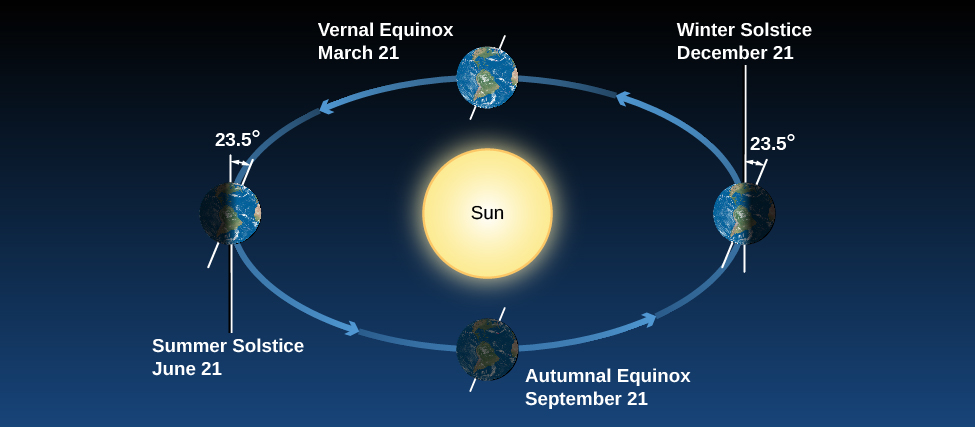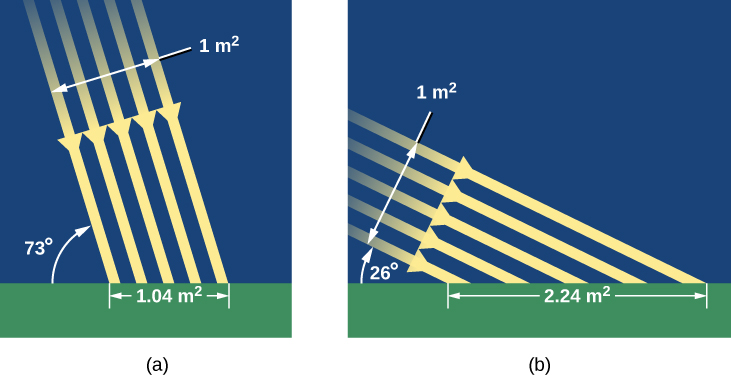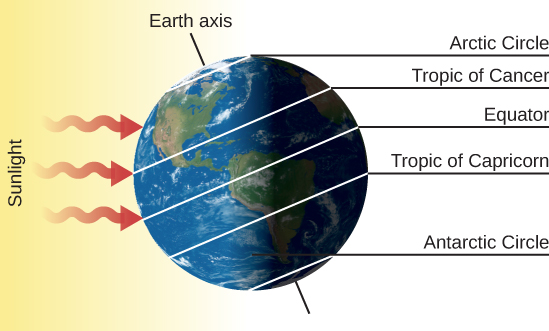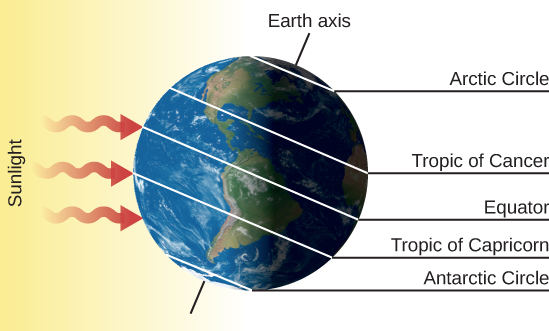The Seasons

Many people have believed that the seasons were the result of the changing distance between Earth and the Sun. This sounds reasonable at first: it should be colder when Earth is farther from the Sun. But the facts don’t bear out this hypothesis. Although Earth’s orbit around the Sun is an ellipse, its distance from the Sun varies by only about 3%. That’s not enough to cause significant variations in the Sun’s heating. To make matters worse for people in North America who hold this hypothesis, Earth is actually closest to the Sun in January, when the Northern Hemisphere is in the middle of winter. And if distance were the governing factor, why would the two hemispheres have opposite seasons? As we shall show, the seasons are actually caused by the 23.5° tilt of Earth’s axis.
The Seasons and Sunshine
Figure 4.5 shows Earth’s annual path around the Sun, with Earth’s axis tilted by 23.5°. Note that our axis continues to point the same direction in the sky throughout the year. As Earth travels around the Sun, in June the Northern Hemisphere “leans into” the Sun and is more directly illuminated. In December, the situation is reversed: the Southern Hemisphere leans into the Sun, and the Northern Hemisphere leans away. In September and March, Earth leans “sideways”—neither into the Sun nor away from it—so the two hemispheres are equally favored with sunshine.


The second effect has to do with the length of time the Sun spends above the horizon (Figure 4.7). Even if you’ve never thought about astronomy before, we’re sure you have observed that the hours of daylight increase in summer and decrease in winter. Let’s see why this happens.
As we saw in Observing the Sky: The Birth of Astronomy, an equivalent way to look at our path around the Sun each year is to pretend that the Sun moves around Earth (on a circle called the ecliptic). Because Earth’s axis is tilted, the ecliptic is tilted by about 23.5° relative to the celestial equator (review Figure 2.7). As a result, where we see the Sun in the sky changes as the year wears on.
In June, the Sun is north of the celestial equator and spends more time with those who live in the Northern Hemisphere. It rises high in the sky and is above the horizon in the United States for as long as 15 hours. Thus, the Sun not only heats us with more direct rays, but it also has more time to do it each day. (Notice in Figure 4.7 that the Northern Hemisphere’s gain is the Southern Hemisphere’s loss. There the June Sun is low in the sky, meaning fewer daylight hours. In Chile, for example, June is a colder, darker time of year.) In December, when the Sun is south of the celestial equator, the situation is reversed.
We also see in Figure 4.8 that the Sun’s rays shine down all around the North Pole at the solstice. As Earth turns on its axis, the North Pole is continuously illuminated by the Sun; all places within 23° of the pole have sunshine for 24 hours. The Sun is as far north on this date as it can get; thus, 90° – 23° (or 67° N) is the southernmost latitude where the Sun can be seen for a full 24-hour period (sometimes called the “land of the midnight Sun”). That circle of latitude is called the Arctic Circle.

Many early cultures scheduled special events around the summer solstice to celebrate the longest days and thank their gods for making the weather warm. This required people to keep track of the lengths of the days and the northward trek of the Sun in order to know the right day for the “party.” (You can do the same thing by watching for several weeks, from the same observation point, where the Sun rises or sets relative to a fixed landmark. In spring, the Sun will rise farther and farther north of east, and set farther and farther north of west, reaching the maximum around the summer solstice.)
Now look at the South Pole in Figure 4.8. On June 21, all places within 23° of the South Pole—that is, south of what we call the Antarctic Circle—do not see the Sun at all for 24 hours.

EXAMPLE 4.1
Seasonal Variations
As you can see in Figure 4.8, the Tropic of Cancer is the latitude for which the Sun is directly overhead on the summer solstice. At this time, the Sun is at a declination of 23° N of the celestial equator, and the corresponding latitude on Earth is 23° N of the equator. If Earth were tilted a bit less, then the Tropic of Cancer would be at a lower latitude, closer to the equator.
The Arctic Circle marks the southernmost latitude for which the day length is 24 hours on the day of the summer solstice. This is located at 90° – 23° = 67° N of Earth’s equator. If Earth were tilted a bit less, then the Arctic Circle would move farther North. In the limit at which Earth is not tilted at all (its axis is perpendicular to the ecliptic), the Tropic of Cancer would be right on Earth’s equator, and the Arctic Circle would simply be the North Pole. Suppose the tilt of Earth’s axis were tilted only 5°. What would be the effect on the seasons and the locations of the Tropic of Cancer and Arctic Circle?
Solution
If Earth were tilted less, the seasons would be less extreme. The variation in day length and direct sunlight would be very small over the course of a year, and the Sun’s daily path in the sky would not vary much. If Earth were tilted by 5°, the Sun’s position on the day of the summer solstice would be 5° N of the celestial equator, so the Tropic of Cancer would be at the corresponding latitude on Earth of 5° N of the Equator. The Arctic Circle would be located at 90° – 5° = 85° N of the equator.
Check Your Learning
Suppose the tilt of Earth’s axis were 16°. What, then, would be the difference in latitude between the Arctic Circle and the Tropic of Cancer? What would be the effect on the seasons compared with that produced by the actual tilt of 23°?
ANSWER:
The Tropic of Cancer is at a latitude equal to Earth’s tilt, so in this case, it would be at 16° N latitude. The Arctic Circle is at a latitude equal to 90° minus Earth’s tilt, or 90° – 16° = 74°. The difference between these two latitudes is 74° – 16° = 58°. Since the tilt of Earth is less, there would be less variation in the tilt of Earth and less variation in the Sun’s paths throughout the year, so there would be milder seasonal changes.
EXAMPLE 4.2
The Position of the Sun in the Sky
The Sun’s coordinates on the celestial sphere range from a declination of 23° N of the celestial equator (or +23°) to a declination 23° S of the celestial equator (or –23°). So, the Sun’s altitude at noon, when it crosses the meridian, varies by a total of 46°. What is the altitude of the Sun at noon on March 21, as seen from a place on Earth’s equator? What is its altitude on June 21, as seen from a place on Earth’s equator?
Solution
On Earth’s equator,
Many cultures that developed some distance north of the equator have a celebration around December 21 to help people deal with the depressing lack of sunlight and the often dangerously cold temperatures. Originally, this was often a time for huddling with family and friends, for sharing the reserves of food and drink, and for rituals asking the gods to return the light and heat and turn the cycle of the seasons around. Many cultures constructed elaborate devices for anticipating when the shortest day of the year was coming. Stonehenge in England, built long before the invention of writing, is probably one such device. In our own time, we continue the winter solstice tradition with various holiday celebrations around that December date.
Halfway between the solstices, on about March 21 and September 21, the Sun is on the celestial equator. From Earth, it appears above our planet’s equator and favors neither hemisphere. Every place on Earth then receives roughly 12 hours of sunshine and 12 hours of night. The points where the Sun crosses the celestial equator are called the vernal (spring) and autumnal (fall) equinoxes.
The Seasons at Different Latitudes
The seasonal effects are different at different latitudes on Earth. Near the equator, for instance, all seasons are much the same. Every day of the year, the Sun is up half the time, so there are approximately 12 hours of sunshine and 12 hours of night. Local residents define the seasons by the amount of rain (wet season and dry season) rather than by the amount of sunlight. As we travel north or south, the seasons become more pronounced, until we reach extreme cases in the Arctic and Antarctic.
At the North Pole, all celestial objects that are north of the celestial equator are always above the horizon and, as Earth turns, circle around parallel to it. The Sun is north of the celestial equator from about March 21 to September 21, so at the North Pole, the Sun rises when it reaches the vernal equinox and sets when it reaches the autumnal equinox. Each year there are 6 months of sunshine at each pole, followed by 6 months of darkness.
the celestial equator passes through the zenith. On March 21, the Sun is crossing the celestial equator, so it should be found at the zenith (90°) at noon. On June 21, the Sun is 23° N of the celestial equator, so it will be 23° away from the zenith at noon. The altitude above the horizon will be 23° less than the altitude of the zenith (90°), so it is 90° – 23° = 67° above the horizon.
Check Your Learning
What is the altitude of the Sun at noon on December 21, as seen from a place on the Tropic of Cancer?
ANSWER:
On the day of the winter solstice, the Sun is located about 23° S of the celestial equator. From the Tropic of Cancer, a latitude of 23° N, the zenith would be a declination of 23° N. The difference in declination between zenith and the position of the Sun is 46°, so the Sun would be 46° away from the zenith. That means it would be at an altitude of 90° – 46° = 44°.
Clarifications about the Real World
In our discussions so far, we have been describing the rising and setting of the Sun and stars as they would appear if Earth had little or no atmosphere. In reality, however, the atmosphere has the curious effect of allowing us to see a little way “over the horizon.” This effect is a result of refraction, the bending of light passing through air or water, something we will discuss in Astronomical Instruments. Because of this atmospheric refraction (and the fact that the Sun is not a point of light but a disk), the Sun appears to rise earlier and to set later than it would if no atmosphere were present.
In addition, the atmosphere scatters light and provides some twilight illumination even when the Sun is below the horizon. Astronomers define morning twilight as beginning when the Sun is 18° below the horizon, and evening twilight extends until the Sun sinks more than 18° below the horizon.
These atmospheric effects require small corrections in many of our statements about the seasons. At the equinoxes, for example, the Sun appears to be above the horizon for a few minutes longer than 12 hours, and below the horizon for fewer than 12 hours. These effects are most dramatic at Earth’s poles, where the Sun actually can be seen more than a week before it reaches the celestial equator.
You probably know that the summer solstice (June 21) is not the warmest day of the year, even if it is the longest. The hottest months in the Northern Hemisphere are July and August. This is because our weather involves the air and water covering Earth’s surface, and these large reservoirs do not heat up instantaneously. You have probably observed this effect for yourself; for example, a pond does not get warm the moment the Sun rises but is warmest late in the afternoon, after it has had time to absorb the Sun’s heat. In the same way, Earth gets warmer after it has had a chance to absorb the extra sunlight that is the Sun’s summer gift to us. And the coldest times of winter are a month or more after the winter solstice.

